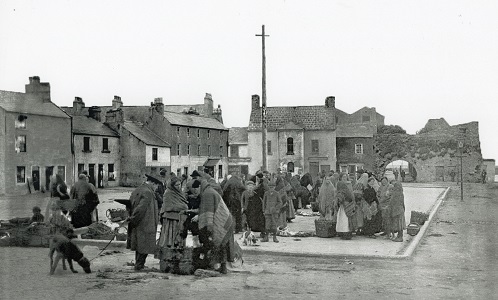THE FISHMARKET

by Tom Kenny
It is a pity really that we cannot see this photograph in colour because what we are looking at must have been a wonderful, colourful, animated scene full of black shawls, patterned and coloured shawls, blue cloaks and red cloaks, white aprons, práiscíns, baskets, scibs, barrels, fisherwomen from the Claddagh, customers from the town. Imagine the noisy competition between the sellers, the lively female eloquence, the haggling ...“Fresh fish, Johnny Dory, Lovely Mackerel” etc. It all sounds like great fun and very romantic but of course it was vital for the Claddagh women who were trying to make a living, to make enough to support their families.
It was only the women who did the selling, never the actual fishermen. As soon as they landed their catch, the women took over. Most of them brought the fish to the large rectangular piece of concrete that you can see in the photograph. It was known as “The Concrate” and was reserved for the buying and selling of fish. When that was not going on it was used by the local kids as a football pitch. Not all the Claddagh women came here, some of them walked the streets with their scibs on their heads, going from house to house selling their fish.
The Fishmarket was very exposed so there would have been no activity there in bad weather. The original fish market was in Bridge Street which was quite a roundabout walk for the women, so when the first Wolfe Tone Bridge opened in 1887, it was a blessing for them. There were other commercial activities here as well. Boat loads of turf and of kelp were unloaded and collected here. There was also quite a market in carrageen moss which also came in by the boatload and many people made a living from it. It was used to thicken stews and soups, for cough mixtures and as a cure for young calves when they were sick. If you were sick there was no better cure than a mixture of lemon juice, carrageen and a drop of ‘the crathur’. The Fishmarket was as important to the town as it was to the Claddagh.
The Spanish Arch in the background was not part of the original city walls but was built in 1584 to protect the quays. The arch to the right was usually closed and was referred to as ‘The Blind Arch’ or “An Póirse Caoch”. Johnny Beatty once operated a forge in this part of the arch.
The houses in the background included the Carricks; Connolly’s Pub; Colm Greene’s Pub; Mrs. Long; a cartmaker named Connor; Tim Shea ; Hynes’. These buildings were occasionally subject to flooding from high tides and gale force winds. There was a local joke in the fifties that the Mayor was Greene, the Bishop was Browne and the Harbourmaster was White.
